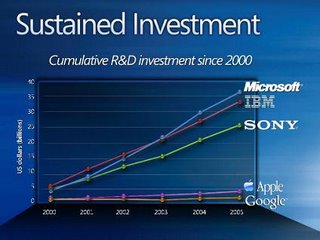In the microsoft analyst day presentations, Ray Ozzie summaries the trends that he sees today : The world is evolving into a highly networked form in which the barriers to participation in almost everything we do are crumbling down—the barriers to sharing, the barriers to contributing and learning, the barriers to working together. As more participants come online, platforms and marketplaces will serve to make exchanges more liquid and more efficient. He also identifies that there’s a fundamental transformation toward services and service-enabled software and Microsoft is investing to utilize services as a means to grow existing and new businesses. How’s Microsoft responding ? He says,
The three most fundamental underpinnings of the approach are:
- First, to continuously increase the number and quality of the service-connected offerings from desktop to Web, to naturally and organically attract users and increase usage.
- A second key underpinning is to continuously increase the ability to optimize the offerings using the aggregated data that the platform infrastructure produces,in a secure manner.
- And the third key factor is to significantly increase the seamlessness of the experiences that users enjoy across multiple PCs and other devices.
Craig Mundie’s presentation tabulates the reported R&D investments amongst the technology majors.  Shocking to say the least when seen together. He points out that big changes take time and effort and highlights the type of innovation that Microsoft is after – on the disruptive, responsive and sustained spectrum. Microsoft spending details is not helping them win the respect of the tech watching community. Innovation on the products/services that most of what the world associates with Microsoft (centered on the desktop) is seen happening in the sustained category – precisely where many see Microsoft to be ineffective/slow moving and seen to be losing ground(MSN search?). Not that it has set the market on fire through disruptive innovation - if anything in the mobile/pervasive/CES space, it is seen that others are defining the agenda. While some cyclical investment surge is understandable – what we are seeing is a trend of progressive increase in spending . Paul Kedrosky points out that Google has added over a $100-billion in market capitalization during the period, while Microsoft has shed around $30-billion in market cap. Similarly, Apple has added around 30-billion in market cap, while IBM has shed around $20-billion.
Shocking to say the least when seen together. He points out that big changes take time and effort and highlights the type of innovation that Microsoft is after – on the disruptive, responsive and sustained spectrum. Microsoft spending details is not helping them win the respect of the tech watching community. Innovation on the products/services that most of what the world associates with Microsoft (centered on the desktop) is seen happening in the sustained category – precisely where many see Microsoft to be ineffective/slow moving and seen to be losing ground(MSN search?). Not that it has set the market on fire through disruptive innovation - if anything in the mobile/pervasive/CES space, it is seen that others are defining the agenda. While some cyclical investment surge is understandable – what we are seeing is a trend of progressive increase in spending . Paul Kedrosky points out that Google has added over a $100-billion in market capitalization during the period, while Microsoft has shed around $30-billion in market cap. Similarly, Apple has added around 30-billion in market cap, while IBM has shed around $20-billion.
As I see it, after all, Apple is rated as the most innovative company by Fortune. As I wrote earlier, one does not necessarily need to spend about five billion in R&D to find that the next big thing does not exist. As Michael Scrage recently wrote brilliantly, the simple fact is that "R&D spending is an input, not a measure of efficiency, effectiveness or productivity. Ingenuity, invention and innovation are rarely functions of budgetary investment & points to the fact that Wal-Mart, Texco and Dell have miniscule R&D budgets, their quality, procurement and growth requirements have probably done more to drive productive innovation investment than any competing initiatives. Growing market competition, not growing R&D spending, is what drives innovation". A successful innovation policy is a competition policy where companies see innovation as a cost-effective investment to differentiate themselves profitably. It is not proper to confuse the number of patents as an index of innovative abilities. In general, process innovation is far more powerful than product innovation – it has a multiplier effect that product innovation can rarely match - the best way to look at innovation activity is the rates of productivity improvement in value add inside enterprises measured against the number of employees Its clearly organizational interest, result orientation, quality of leadership and the latitude the research team has and the integration that business and research has within the enterprise that matters a lot. Clearly these are the factors that get severely affected when organization grows. It’s time to look at assessment of new product /new revenue streams coming out of enterprises(Microsoft in this case) lot more closely as they begin to grow.
Category :Innovation, Emerging Trends, Microsoft
|

